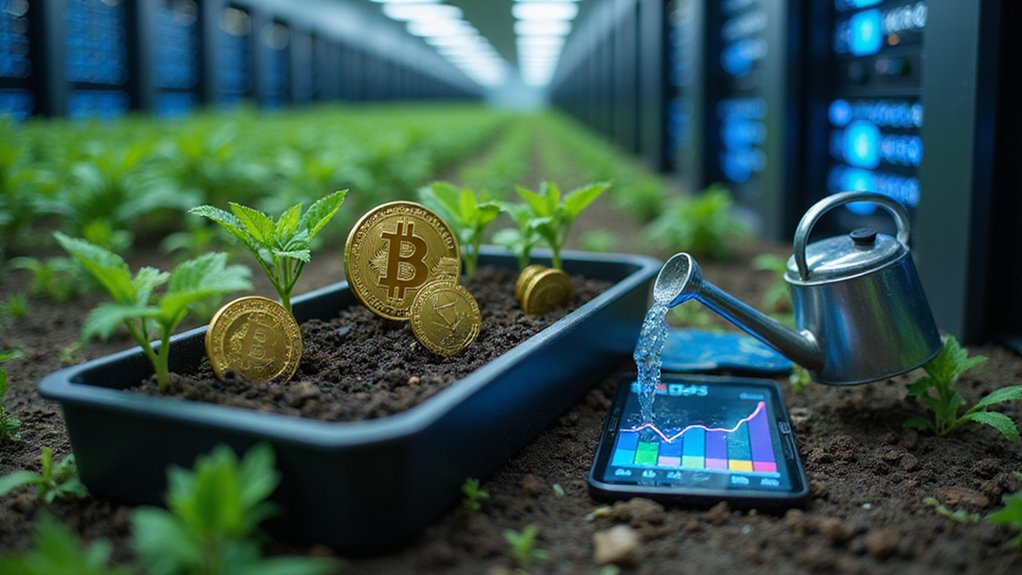Yield farming represents DeFi’s equivalent of putting money to work—minus the suited intermediaries. By depositing cryptocurrency into liquidity pools, users earn returns through transaction fees and governance token distributions that can reach triple-digit APYs (though such yields rarely arrive without commensurate risk). Smart contracts automate the process across platforms like Aave and Compound, enabling complex strategies from simple liquidity provision to cross-protocol optimization. The mechanics may seem byzantine, but the underlying principle remains reassuringly familiar.

The labyrinthine world of decentralized finance has spawned numerous wealth-generation strategies, but few have captured the imagination of crypto enthusiasts quite like yield farming.
This DeFi mechanism allows investors to stake or lend their cryptocurrency assets through various protocols, generating returns that would make traditional bankers blush—though not without commensurate risk.
At its core, yield farming represents the digital equivalent of putting one’s money to work, albeit with algorithmic efficiency rather than human fund managers.
Money digitally employed through code, not committees—DeFi’s algorithmic answer to passive income
The mechanics of yield farming operate primarily through liquidity provision—users deposit token pairs into pools on decentralized exchanges, receiving LP tokens that represent their proportional ownership.
These tokens serve as both proof of contribution and claim to the rewards generated through transaction fees and governance token distributions. The most popular platforms like Aave and Compound attract liquidity providers with their algorithmic interest rates.
The smart contracts underpinning these systems execute with machine precision (until, of course, they don’t).
While traditional fixed-income investments might offer single-digit returns in a favorable year, yield farming can—in certain circumstances—deliver triple-digit APYs.
These astronomical figures stem from a combination of transaction fee sharing and the distribution of governance tokens, which themselves may appreciate in value.
Additionally, yield farmers often employ compounding strategies, reinvesting earned tokens to maximize returns through the miracle of exponential growth.
The pursuit of such yields, however, isn’t without peril.
Impermanent loss—that curious phenomenon where providing liquidity can underperform simply holding assets—lurks as a constant threat.
Smart contract vulnerabilities may transform a promising yield farm into a hacker’s harvest.
Market volatility, liquidation risks, and the regulatory sword of Damocles further complicate matters.
Governance tokens earned through yield farming also grant users the ability to participate in protocol decision-making, creating an additional value layer beyond mere financial returns.
Sophisticated farmers employ diverse strategies across platforms like Uniswap, PancakeSwap, Aave, and Compound, often utilizing yield aggregators to optimize returns.
PancakeSwap has gained popularity among yield farmers due to its low transaction fees and multi-chain support that expands opportunity across different blockchain networks.
The truly dedicated monitor their positions with near-religious devotion, migrating capital in pursuit of maximum yields.
In this financial ecosystem where opportunities emerge and evaporate with alarming rapidity, today’s lucrative strategy might become tomorrow’s cautionary tale.
Frequently Asked Questions
What Are the Tax Implications of Yield Farming?
Yield farming’s tax implications are, unsurprisingly, as convoluted as the protocols themselves.
Rewards typically constitute taxable income at their fair market value upon receipt (establishing one’s cost basis), while subsequent disposition of these assets may trigger capital gains.
Jurisdictional variations abound—U.S. investors face income or capital gains treatment, while international farmers navigate their own regulatory thickets.
Record-keeping becomes paramount; the blockchain’s transparency offers little comfort when reconciling transactions across multiple liquidity pools come tax season.
How Does Impermanent Loss Affect Yield Farming Returns?
Impermanent loss silently erodes yield farming returns when asset prices diverge from their initial deposit ratio—a mathematical certainty that often outpaces the trading fees earned.
The greater the price deviation between paired tokens, the more severe the damage.
While technically “impermanent” until withdrawal, this phenomenon represents a genuine opportunity cost that yield farmers must factor against their projected APYs.
Stablecoin pairs offer refuge from this particular demon, though at the cost of reduced yield potential.
Can Yield Farming Protocols Be Insured Against Hacks?
Yes, yield farming protocols can indeed be insured against hacks through specialized DeFi insurance protocols like Nexus Mutual, Cover Protocol, and InsurAce.
These services offer coverage against smart contract failures, exploits, and other technical vulnerabilities—though with notable limitations.
Premiums vary based on protocol risk profiles, and coverage often remains insufficient for catastrophic losses.
The governance mechanisms, while decentralized, can introduce claim processing delays and contentious decisions.
(A prudent yield farmer insures what they cannot afford to lose.)
Which Wallets Best Support Yield Farming Activities?
For yield farming, MetaMask remains the industry stalwart—ubiquitous across Ethereum-based protocols while Trust Wallet offers broader multi-chain flexibility.
Security-conscious farmers gravitate toward Ledger hardware solutions (particularly when paired with MetaMask).
Coinbase Wallet provides user-friendly DeFi access for newcomers, while TokenPocket and imToken serve as extensive options for those venturing beyond mainstream chains.
The ideal wallet ultimately depends on one’s risk tolerance and whether auto-compounding features trump security considerations.
How Do Regulatory Changes Impact Yield Farming Opportunities?
Regulatory changes fundamentally reshape yield farming’s risk-reward equation.
While increased oversight can deflate certain high-yield opportunities (farewell, regulatory arbitrage), it simultaneously fortifies platforms against exploits and rug pulls.
The compliance burden inevitably raises operational costs, compressing yields for participants.
Yet paradoxically, clearer frameworks may attract institutional capital—potentially creating more sustainable, if less lucrative, farming ecosystems.
The savvy yield farmer must now add regulatory intelligence to their toolkit alongside technical analysis.









